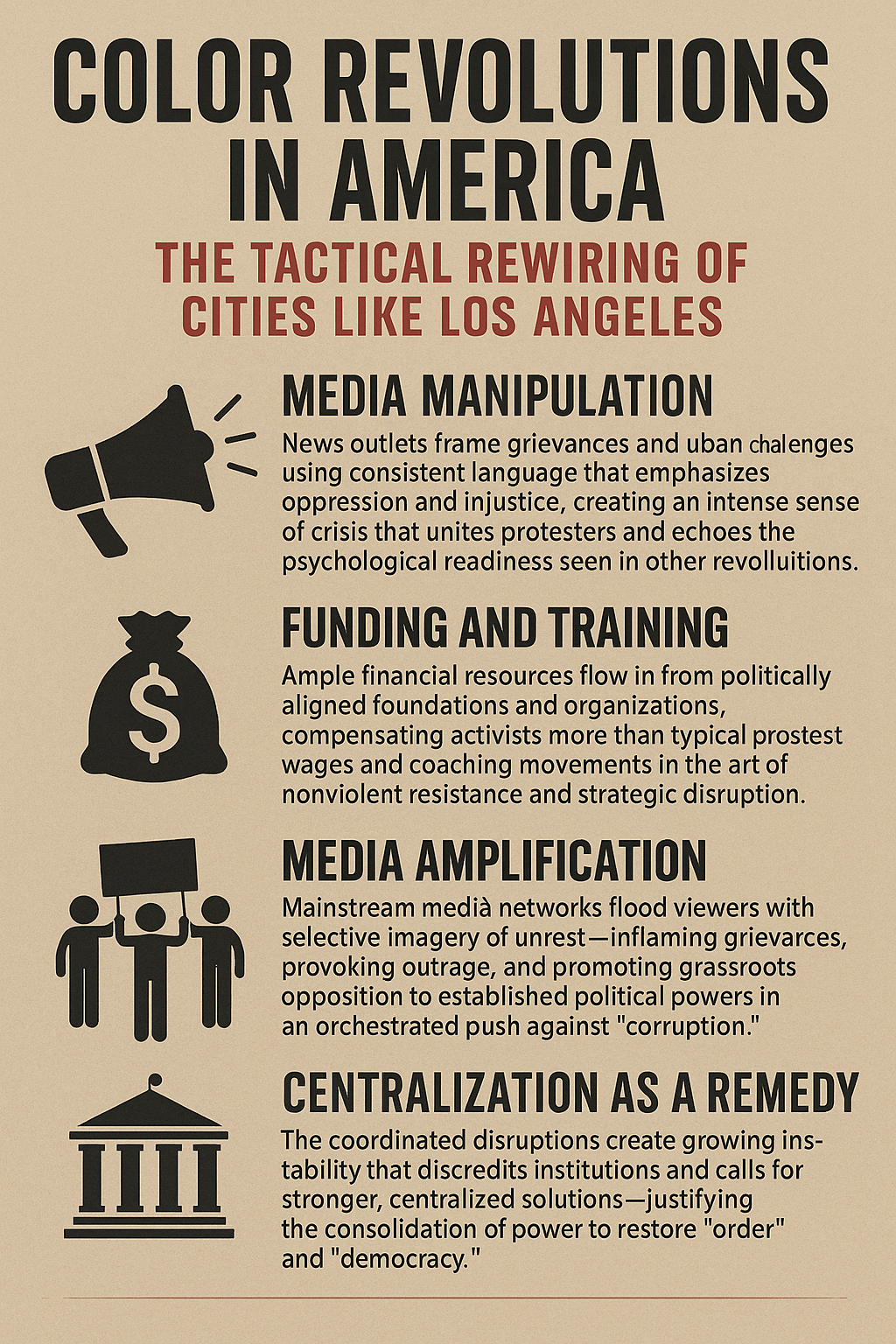Color revolutions, long considered the domain of post-Soviet or Middle Eastern regime changes, are increasingly manifesting in Western democratic cities, including major U.S. hubs like Los Angeles. Though often branded as grassroots movements for justice or reform, many of these uprisings are far from organic. They employ calculated strategies to manipulate public perception, incite social unrest, and justify centralized control—all under the banner of democracy.
What Are Color Revolutions?
Color revolutions are political movements—usually nonviolent in name but often chaotic in effect—engineered to unseat governments, shape ideologies, or coerce institutions. Historically funded by foreign powers or elite NGOs, these movements:
- Use mass protests to create a climate of crisis.
- Leverage media saturation to shape public narratives.
- Undermine traditional institutions under the pretext of reform.
The playbook was first seen in places like Serbia (“Bulldozer Revolution”), Georgia (“Rose Revolution”), Ukraine (“Orange Revolution”), and the Arab Spring. Now, similar tactics are appearing in Western cities—especially Los Angeles.
Why Los Angeles?
Los Angeles is a perfect target:
- Cultural Capital: What happens in LA affects the nation. Its entertainment industry controls narrative.
- Diversity: Multiple ethnic communities allow activists to exploit racial, immigration, or class tensions.
- Weak Institutions: Years of political gridlock and budget crises make enforcement difficult.
- Ideological Polarity: Deep divisions allow for easy framing of any issue as a moral crusade.
How the Tactics Are Applied
Manufactured Crisis
Through relentless media coverage, LA is often painted as a dystopian wasteland—crime-ridden, lawless, and in desperate need of federal or outside intervention. This is a deliberate exaggeration strategy, designed to:
- Provoke public fear.
- Delegitimize local leaders.
- Justify intervention.
NGO and Activist Funding
Groups like CHIRLA and PSL receive millions in funding, both from local government and private institutions. While many do legitimate community work, their overlap with political activism blurs the line:
- Funding fosters loyalty.
- Loyalties shape narratives.
- Narratives mobilize unrest.
Trained Protest Networks
Many demonstrations are not spontaneous. They are coordinated by experienced groups like the Ruckus Society or trained community organizers who:
- Use media kits and press handlers.
- Distribute protest roles (e.g., “medics,” “de-escalators”).
- Train in how to provoke arrest while remaining legally protected.
Information War & Disinfo Campaigns
Color revolutions require perception control:
- Social media is flooded with viral videos—some authentic, others edited.
- Hashtags and slogans are deployed like weapons.
- Fake accounts promote rage-bait to divide communities.
Weaponizing Victimhood and Identity Politics
The narrative is often simplified into oppressed vs. oppressor dichotomies:
- Police vs. Minorities
- Immigrants vs. ICE
- Workers vs. Capitalism
This framing keeps people from asking deeper questions about who benefits from the chaos.
The Hidden Agenda
The goal isn’t justice. It’s power. These tactics aim to:
- Destabilize communities.
- Erode public trust.
- Justify increasing central authority.
- Consolidate control in globalist or elite entities.
The Role of the Public: Pawn or Citizen?
Most people involved are not villains. They are pawns—motivated by real pain but manipulated by false solutions. Recognizing the tactic is the first step toward reclaiming your mind.
Citizens must:
- Become media literate.
- Ask who profits.
- Follow the funding.
- Reject narrative traps.
A Time for Discernment
Color revolutions masquerade as justice but result in deeper chains. In cities like Los Angeles, the public must stop applauding the actors and start watching the directors. The goal isn’t the scene you see on the stage—it’s the long-term rewrite of the nation’s script.
True reform rises not from chaos, but from clarity. Not from slogans, but from substance. Not from color revolutions—but from conscience revolutions.






